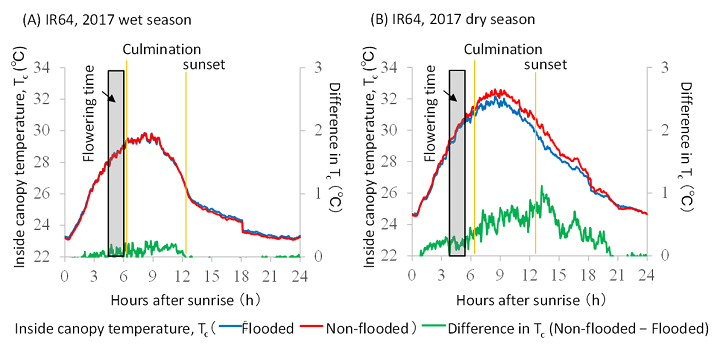Effect of non-flooded water management on inside-canopy temperature dynamics, spikelet sterility, and grain yield of lowland rice in the tropics
Description
Increasing temperatures and water scarcity are concomitant threats to sustainable rice production in future climates. Although both aspects have been widely studied, little is understood about how water-saving management might affect heat-induced stress and grain yield of rice under open-field conditions. We implemented field experiments in four consecutive wet and dry seasons in the sub-humid tropics of northern Ghana to clarify how water management practices affect daily inside-canopy temperature (Tc) dynamics, flowering time, heat-induced spikelet sterility, and grain yield of rice. Two rice varieties, IR64 and Jasmine85, were grown under two water regimes: 1) continuous flooding (Flooded), and 2) continuous flooding except for an approximately 20-day drainage treatment at the flowering period (Non-flooded). The Non-flooded treatment maintained high moisture contents above 60% of saturated volumetric water to avoid any significant drought stress. Inside-canopy temperature (Tc) during the flowering periods were monitored at 2-minute intervals by placing MINCER (Micrometeorological Instrument for the Near-Canopy Environment of Rice) inside the canopy.The effect of water regimes on grain yield and Tc differed significantly between the dry season (DS) and wet season (WS). Non-flooded management significantly reduced yields by 13–26% in the DS but not in the WS (Table 1). However, the effect of Non-flooded management on Tc at flowering time (0.2–0.3°C increase across varieties and years) (Figure 1) and spikelet sterility (3–5% increase) (Table 1) was relatively small even in the DS. In contrast, Non-flooded management greatly increased Tc from solar noon to midnight in the DS (Fig. 1). Tc did not differ between Non-flooded and Flooded treatments either at flowering time or nighttime in the WS (Fig. 1).
Tc changes over the course of the day imply that Non-flooded management may have a higher risk of yield reduction in the DS of the sub-humid tropics by increasing late-afternoon-to-nighttime temperatures, which can cause physiological stress and respiration loss. The results can help improve water-saving management practices under contrasting climatic conditions in the sub-humid tropics and predict the combined effect of increasing temperatures and water scarcity on rice production.
Figure, table
-
Table 1. Effect of water management on spikelet sterility and grain yield
Variety Water management Spikelet sterility (%) Grain yield (t ha-1) Wet season Dry season Wet season Dry season 2016 2017 2017 2018 2016 2017 2017 2018 IR64 Flooded 2.4b 8.9a 4.1b 4.0a 6.1ab 5.2a 6.1b 6.3b Non-flooded 2.3b 5.9a 7.5ab 8.9a 5.4b 5.0a 5.2c 4.7c Jasmine85 Flooded 5.7a 10.8a 6.7b 4.2a 6.6ab 5.6a 7.4a 7.7a Non-floodd 2.6b 8.2a 11.8a 7.2a 7.0a 5.5a 6.4b 6.4b Two varieties were allocated in 5.7 m × 4.5 m plots with 4 replicates, in different water management practices.
Different alphabets indicate significant differences at 5% by Tukey's HSD test.
*Flooded: Continuously flooded from transplanting to maturity.
*Non-flooded: Continuously flooded except for an approximately 20-day continuous non-flooded period, at around the heading dates of the two varieties. Volumetric moisture contents of soils were retained above 30% during the non-flooded period in all seasons except the dry season cultivation in 2018 in which volumetric moisture content went down to 26% due to the lack of irrigation water.
-
Figure 1. Diurnal changes in inside-canopy temperature (Tc) in the Flooded and Non-flooded water management and the Tc differences between these two management schemes for IR64 in the 2017 wet seasons and 2017 dry seasons
The trend was equivalent for both varieties and in the other years.
The average of two replicates over peak flowering days (7 observation days around the day of 50% heading excluding any rainy days) is depicted. Grey bars within each figure indicate the period from initial to peak spikelet opening time which were determined by digital images taken at 10-minute intervals. Orange lines indicate the solar noon and apparent sunset time.
- Affiliation
-
Japan International Research Center for Agricultural Sciences Crop, Livestock and Environment Division
- Classification
-
Research
- Program name
- Research Project
-
Multi-site monitoring network of canopy micrometeorology and environmental stresses of rice for the climate change adaptation evaluation
- Term of research
-
FY2020(FY2015~FY2021)
- Responsible researcher
-
Tsujimoto Yasuhiro ( Crop, Livestock and Environment Division )
ORCID ID0000-0001-7738-9913KAKEN Researcher No.: 20588511Yoshimoto Mayumi ( Institute for Agro-Environmental Sciences, NARO )
Fukuoka Minehiko ( Institute for Agro-Environmental Sciences, NARO )
Feseini Abraham ( Savanna Agricultural Research Institute, CSIR, Ghana )
Inusah Yahaya ( Savanna Agricultural Research Institute, CSIR, Ghana )
Dogbe Wilson ( Savanna Agricultural Research Institute, CSIR, Ghana )
- ほか
- Publication, etc.
-
Tsujimoto Y et al. (2020) Field Crops Res.https://doi.org/10.1016/j.fcr.2020.107978
- Japanese PDF
-
2020_B12_A4_ja.pdf280.87 KB
2020_B12_A3_ja.pdf284.64 KB
- English PDF
-
2020_B12_A4_en.pdf257.88 KB
2020_B12_A3_en.pdf263.67 KB
- Poster PDF
-
2020_B12_poster.pdf193.79 KB
* Affiliation at the time of implementation of the study.

